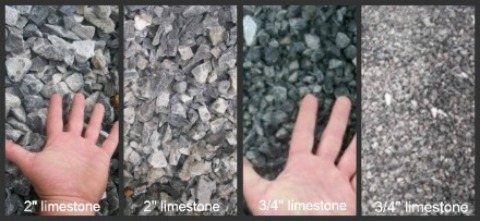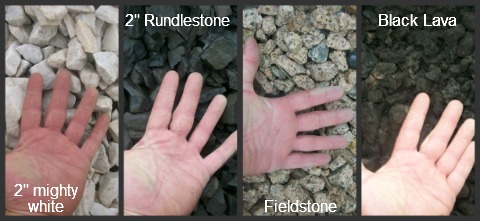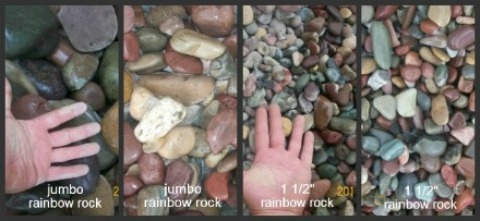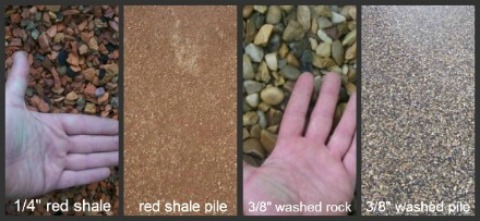E. Types of Rocks
There are many different types of rocks used in landscaping today, so in
this section we are going to look at decorative rocks.
They make great low maintenance ground covers for perennial beds, xeriscaping, or anywhere else grass will struggle.
Great examples of where grass doesn't grow are: between closely built houses, under trees with thick canopies, and alongside driveways that experience winter kill.
Decorative Rock = Decorative rock is a collective term we use to describe the different types of rocks we use to decorate our yards as groundcovers.
Before we proceed any further let's review where we are for those of you that have just joined us on this page.
Some of you may have been looking for gravel or sand for a sub-base under a project. We have that as well, but please take one step back to our types of gravel article.
Larger feature boulders and rocks will be covered in our next section called buying rock. All these sections combined, make up our educational series on "Landscaping Yards". This has been designed to help homeowners get started in the landscaping process. Don't forget the links for the whole series are at the bottom of this page.
Now let's continue on with other uses for decorative rocks.
Pea gravel for playgrounds, walkways, and paths are other areas
these products can be used. These rock types can be used to compliment
features in your yard, or to make subtle grade changes. Whatever the
reason, we hope you find this article helpful.
Practical thinking for your Project
It is important to remember to choose rocks for landscaping that are practical for the purpose.
Don't use pea gravel down the side of a house, if you need to push a mower from the front yard to the backyard. You will not be happy with your purchase.
Large river rock would not be practical if you are going to walk over it frequently. The size and shape of the stones should be considered if you have to walk on them.
Shape is also important in another way. Mechanical bond is the ability of jagged edges to hold together better than rounded materials like pebbles or river rocks. (Ideally a 3/4 inch crushed product would work well for walking on.)
If it is used in the winter, make sure it does not become a hazard for you or any visitors. Also remember that shoveling snow on top of rocks in the winter can be challenging. It can end up in your lawnmower when spring time rolls around.
For more tips visit our how-to modules for specific information on the project you are working on.
Popular types of Decorative Rocks
We talked about sand, gravel and soil, usually being sold by the cubic yard in the last section. Estimating for decorative rocks will be done using the same formulas. Before we get into estimating, let's look at a few pictures of what may be available to you and what you may use them for.
There are many different kinds, colors, shapes, and sizes of decorative rocks. To get a perspective on the size of many rocks available we sometimes place a hand in the picture for comparing.
We also have some wet and dry pictures of the rocks. (It was cool and rainy on picture day). There are some rocks that actually look better with the wet look, and some people actually use sealers to preserve this look.
Most decorative rocks typically come in a variety of sizes
from a fine crush, up to a couple of inches or more.
Different types of 2 inch rocks.
Pea Gravel can also be called playground gravel.
Regional Differences
In the introduction, we talked about different names for natural products. They are frequently named after the quarry they come from. There are certain stones that are well known across North America like: Montana Rainbow, Pennsylvania Bluestone, and Arizona Flagstone.
If your local yard doesn't have it by name, try to have a picture or be able to describe it. Chances are that they have it, but call it something different.
One of the most popular choices today are the rainbow rocks.
River rock landscaping and xeriscaping are very popular as water conservation is becoming increasingly important. There are different sizes and colors to choose from. Jumbo rainbow rock is a very popular choice for xeriscaping, dry creek beds, as well as ground covers. Rainbow rock is known for providing the nicest mix of colors.
The biggest advantage of using decorative rocks as a low maintenance ground cover is the long term savings. Upfront costs may be a slightly higher, but the long term maintenance costs of lawn are far more expensive. Mowing, fertilizers, and water are all things to consider when deciding between decorative rocks vs lawn.
More options of decorative rocks.
Keep in mind when choosing rocks like Red Shale, that the color may fade over time. 3/8 washed rocks (shown above), is probably one of the cheapest ground covers. This is one of the best choices for areas of low visibility, like under a patio, or between houses. Don't spend a ton of money on expensive decorative rocks if nobody will see them.
If you are looking for some great tips on installing decorative rocks, visit our how-to module on Edging and Decorative Rock.
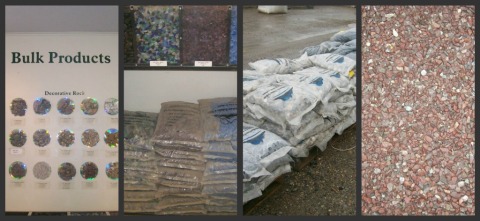
Above left showing Ornamental Stone's display board.
A great way to start your shopping before venturing into the yard.
Decorative rock can also be sold by the bag.
Estimating for Decorative Rocks
To estimate the amount of decorative rocks, we will use the same formula we used for gravel in the previous section.
Take the length times the width of your excavation area, and multiply it by the depth (LxWxD). This will give you the cubic feet of sub base material you will need.
- For example: A rock bed that is 12 feet by 6 feet with a 3 inch gravel base will look like this.
(Don't forget to convert the inches in depth to ft. by dividing the inches by 12, 3 inches divided by 12 is .25 of a foot).
12 ft. times 6 ft. = 72 sq. ft. times 3 inches. (.25 of a ft. ) = 18 cubic ft.
Most landscape yards sell in cubic yards, so you will need to convert cubic feet to cubic yards by dividing by 27.
18 divided by 27 = .66 cubic yards of gravel required.
Need help? Use our volume conversion calculator to convert from cubic feet to cubic yards.
For more information on estimating go to our Quick Landscaping Estimating Reference for formulas and examples.
UnitConversion.org - online unit converter of length, weight, volume, area, and more.To account for settling and to make sure you have sufficient coverage over your landscape fabric, increase your amount by 5 to 10%. Rounding up with most orders will usually cover your needs. This means .66 yards becomes 1 full yard. It is always better to have a little more than not enough.
Most landscape supply yards sell in one yard, and half yard buckets. They may let you fill buckets, or sell bagged products for smaller areas. (Bulk purchase are usually the cheapest way to buy.)
Pretty simple, right?
Now you have the magical formula for estimating gravel, soil, decorative rock, sand, and anything else sold by the square foot, cubic foot, or cubic yard.
Let's take a look now at some more natural stone products, including: big rocks and feature boulders. Here is information on buying rock.
______________________________________
Introduction Estimating Materials
Table of Contents: Landscaping Yards
A. Landscaping Yards Introduction
C. Patio Bricks and Paver Stones
F. Buying Rock
H. Other Landscaping Materials
I. Quick Landscaping Estimating Reference
Table of Contents: Buying Soil
______________________________________
Return to the Estimating Materials Introduction
Go to the Dream Yard Home Page
Check out our time and money saving e-book
How to avoid the biggest mistakes made by DIYers, designers, and landscaping companies.
Visitor
Favorites
Giggles 'n' Thoughts
